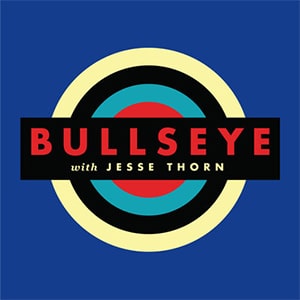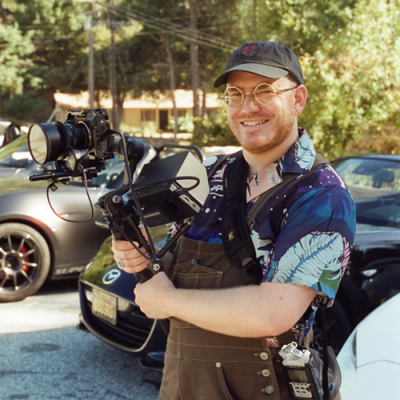Transcript

jesse thorn
It’s Bullseye. I’m Jesse Thorn. Now it’s time for Cannonball.

music
Thumpy, relaxed rock music punctuated with cheers and a splash.

jesse
It’s a segment where we take classic albums or albums that probably ought to be classics and bring smart, funny people onto the show to tell us what makes them so great. This time, we’ll hear from Nathan Rabin. Nathan is a writer. He’s covered pop culture for The AV Club and The Dissolve, among others. He’s also the author of several books. He wrote Weird Al: The Book and another one called You Don’t Know Me, but You Don’t Like Me: Phish, Insane Clown Posse, and My Misadventures with Two of Music’s Most Maligned Tribes. Nathan has a new book out—an even deeper dive into Weird Al. It’s called The Weird Accordion to Al: Every Weird Al Yankovic Album Obsessively Analyzed. So, really, who better to bring on our show to obsessively analyze a classic Weird Al album? Anyway. Nathan’s Weird Al record of choice? 1984’s Weird Al Yankovic in 3-D. Here’s Nathan Rabin.

nathan rabin
In 3-D was Weird Al’s second album and he was in a very interesting, a very kind of singular space where he was following up his 1983 debut, his self-titled debut. They had no idea if this guy had any kind of a future as a recording artist. You know. He was still a fluke. He was still, you know, kind of somebody who got lucky with a couple of songs on his first album. So, I feel like in a lot of ways, this was his true debut. Another way in which the debut feels not quite genuine, you know, is that a lot of the songs on it had already been released. [Music fades in.] “My Bologna” had already been released as a single, on Capitol—

music
“My Bologna” by Weird Al Yankovic from the album “Weird Al” Yankovic. Oooh, my little hungry one, Hungry one. Open up a package of my bologna. Oooh, I think the toast is done, The toast is done. [Volume decreases to play under Nathan speaking.]

nathan
—an entire decade earlier, you know. It came out around Christmas time in 1979. So, he was—I feel that this was kind of his shot. You know? To put in things in Eminem terms. This was his moment! And he had to seize it and kind of prove to the world that he was a recording artist, that he was legitimate, that he was genuine. I mean, to himself I think he probably had to prove that, like, “I didn’t make a mistake not being an architect.” Another thing that really [stammers] separates this from the debut is that, on that one, every single song the accordion was kind of the primary instrument. And that was a big part of the gimmick. You know? That was a big part of the novelty of what made him different is here was this crazy kid performing rock and roll music on an accordion. [Music fades out.] With In 3-D, they realized the limitations of that. They realized, “We don’t wanna just be wacky.” You know. “We don’t wanna just be outrageous. We want to create something that will connect with the mainstream.”

music
“Eat It” from the album Weird Al Yankovic in 3-D by Weird Al Yankovic begins to play under the dialogue.

nathan
The first song and the first single on In 3-D is probably the song you’re most familiar with, if you are a Weird Al fan. If you’re not a Weird Al fan, that song is the zeitgeist capturing smash hit, “Eat It.”

music
[Music volume increases.] How come you're always such a fussy young man Don't want no Cap'n Crunch, don't want no Raisin Bran Well don't you know that other kids are starvin' in Japan So, eat it, just eat it Don't want to argue, I don't want to debate Don't want to hear about what kinds of foods you hate You won't get no dessert 'till you clean off your plate So, eat it Don't you tell me you're full Just eat it, eat it Get yourself an egg and beat it Have some more chicken Have some more pie [Volume decreases and plays under Nathan’s dialogue.]

nathan
By now, this would be another example of him taking what you would imagine would be a very, very limited idea or a very limited formula and making something really wonderful out of it and incredibly overachieving. I feel like with all of the parodies, they’re just so unbelievably overachieving and if you just look at the comic idea, they’re not that inspired. But the execution and the attention to detail is what makes it transcendent and what makes it—makes you able to listen to it over and over and over again.

music
[Music volume increases.] You haven't even touched your tuna casserole You better chow down, or it's gonna get cold So, eat it. I don't care if you're full Just eat it, eat it Open up your mouth and feed it [Music is abruptly interrupted by the next song.]

music
“Mr. Popeil” from the album Weird Al Yankovic in 3-D by Weird Al Yankovic. I need a vegematic! I need a pocket fisherman! I need a handy appliance That'll scramble an egg while it's still inside its shell! (Operators are standing by. How does that make you feel?) [Volume decreases and plays under Nathan’s dialogue.]

nathan
Another noteworthy song on this album is “Mr. Popeil” and one of the things that Al does that people don’t necessarily know about or don’t understand or appreciate the way they do his parodies, is he does pastiches, or he does style parodies. And what he’ll do is he will take an artist who he loves, like Devo or The Talking Heads or, in this case, The B-52’s. And he will take their music apart and then put it back together and basically create a song that they would do. [Laughs.] In an alternate universe. Or ultimately a song that they would never do, and that’s where the humor comes from.

music
[Music volume increases.] Mr. Popeil! Mr. Popeil! Mr. Popeil! [Volume decreases and plays under Nathan’s dialogue.]

nathan
And with B-52’s and “Mr. Popeil”, there’s this interesting non-incongruity, where it is kind of a zany, wacky sounding song about wacky, zany subject material that sounds zany and wacky as well. [Music fades out.] And it is a tribute/parody/homage of the Popeil family.

music
“King of Suede” from the album Weird Al Yankovic in 3-D by Weird Al Yankovic. There's a sale on our gabardine suits today They're all thirty percent off from yesterday [Volume decreases and plays under Nathan’s dialogue.]

nathan
“King of Suede” is one of my very favorite songs on here. And I think one of the things that makes it work so spectacularly well is that is a parody of a Police song and, The Police, almost their defining characteristic is they took themselves very, very, very seriously. The song is very dour. The song is very serious. I mean, [laughing] it’s literally called “King of Pain”. If Sting and The Police had a sense of humor, if they had a sense of humor of themselves, that would be self-parody. But they don’t. So, it took Al to do external parody to it.

music
[Music volume increases.] We got portly and regular and extra-long (Is my size up there?) We got tailors to fix it, if it comes out wrong (Is my size up there?) We got all kinds of sweatshirts, you can take your pick (Is my size up there?) With the collars ripped off, like that Flashdance flick (Is my size up there?) [Volume decreases and plays under Nathan’s dialogue.]

nathan
Another thing that makes this the best Weird Al Yankovic album is that he was a real creature of new wave. Like, that was his moment. That—were his people, they have synthesizers, they were weird, they had a sense of humor about themselves. And this and the follow-up, Dare to Be Stupid, like those are his new wave albums where you feel like there’s not that distance, necessarily, between who he is as an artist and who he is parodying and who he’s taking inspiration from. There’s just this kind of wonderful confluence of subject matter and then sound.

music
[Music volume increases.] There's a sale on our double-knit slacks today [“King of Suede” is abruptly interrupted by the next song.]

music
“Polkas on 45” from the album Weird Al Yankovic in 3-D by Weird Al Yankovic. [Volume decreases and plays under Nathan’s dialogue.]

nathan
This is the first of his albums that has a polka medley. And before I started writing about him, before I started collaborating with him, I think I always saw that as filler? You know? It’s just kind of like something that is fun, you know, but kind of disposable. And over the course of this project, I came to see it as very, very central to who he is as a musician, to what his whole ideology is, and what that is is puncturing pop pretention.

music
[Music volume increases.] Singley do look awful kuh-kuh-cold (talkin' 'bout my generation) Hope I die before I get old (talkin' 'bout my generation) This is my generation (talkin' 'bout my generation) This is my generation, baby (talkin' 'bout my generation) (talkin' 'bout my generation) My, my, my, my, my, my generation (my generation) Well, I’m talkin' 'bout my g-g-g-g-g-g-g-g-g-g-g-g-g-generation Hey! [Music ends.]

music
“Nature Trail to Hell” from the album Weird Al Yankovic in 3-D by Weird Al Yankovic. [Volume decreases and plays under Nathan’s dialogue.]

nathan
He closes the album on “Nature Trail to Hell” and I kind of—I have a lot of different goofs and a lot of riffs on the—on the—in the book. One of which is I kind of posit him as the accidental founder of horrorcore? Which is the kind of rap music that’s very influenced by horror movies and violence and serial killers and Insane Clown Posse are an example of that. Geto Boys. And I’m kind of joking? And I’m kind of not joking. Because there is a lot of horrific and violent and disturbing imagery in his songs and “Nature Trail to Hell”, which is the final song on the album, that’s when he gets really dark and really weird and kind of experimental and kind of aggressive. Again, this is the kind of song that dares you to turn it off. Or this is the kind of song that dares mothers and fathers to turn it off.

music
[Music volume increases.] Don't spoil the big surprise You won't believe your eyes when you see Nature trail to hell Nature trail to hell Nature trail to hell In 3-D [Volume decreases and plays under Nathan’s dialogue.]

nathan
Pretty amazing and, yeah, I’ve been shocked at what an amazingly fertile and rich subject, sort of, Weird Al Yankovic has been and how much sort of bigger and more expansive than I think, kind of, people’s conception of him, sort of his career, has really been. This is Weird Al’s masterpiece and he is the best and most successful person in the world at what he does.

music
[Music volume increases.] No, you'll never see hideous effects like these again 'Till we bring you "nature trail to hell part 2" So, bring the kids along, it's good clean family fun What have you got to lose? If you like the six o'clock news then you'll love Nature trail to hell Nature trail to hell [Volume decreases and plays under Jesse’s dialogue before fading out.]

jesse
Nathan Rabin, on the record he submits to the canon of great works of popular music: Weird Al Yankovic in 3-D. Nathan Rabin’s book, The Weird Accordion to Al: Every Weird Al Yankovic Album Obsessively Analyzed is out now in a special, 500-page expanded edition. Rabin truly leaves no stone left unturned in the Weird Al oeuvre and we are eternally grateful to Nathan for taking on that mighty task.

music
Thumpy, relaxed music.

jesse
That’s the end of another episode of Bullseye. Bullseye is produced out of the homes of me and the staff of Maximum Fun, in and around greater Los Angeles, California—where, just the other day, I went onto WeatherUnderground.com to check what the weather forecast for the next day was and it said, “Tomorrow is forecast to be much cooler than today.” And the forecast for tomorrow was 96. High of 96. Much cooler. 96. That’s where we’re at, here in Los Angeles. The show is produced by speaking into microphones. Our producer is Kevin Ferguson. Jesus Ambrosio and Jordan Kauwling are our associate producers. We get help from Casey O’Brien. Our interstitial music is by Dan Wally, also known as DJW. Our theme song is by The Go! Team. Thanks to them and to their label, Memphis Industries, for letting us use it. You can keep up with the show on Facebook, Twitter, and YouTube. Just search for Bullseye with Jesse Thorn. And I think that’s about it. Just remember: all great radio hosts have a signature sign off.

promo
Speaker: Bullseye with Jesse Thorn is a production of MaximumFun.org and is distributed by NPR. [Music fades out.]
About the show
Bullseye is a celebration of the best of arts and culture in public radio form. Host Jesse Thorn sifts the wheat from the chaff to bring you in-depth interviews with the most revered and revolutionary minds in our culture.
Bullseye has been featured in Time, The New York Times, GQ and McSweeney’s, which called it “the kind of show people listen to in a more perfect world.” Since April 2013, the show has been distributed by NPR.
If you would like to pitch a guest for Bullseye, please CLICK HERE. You can also follow Bullseye on Twitter, YouTube, and Facebook. For more about Bullseye and to see a list of stations that carry it, please click here.
Get in touch with the show
People
How to listen
Stream or download episodes directly from our website, or listen via your favorite podcatcher!






